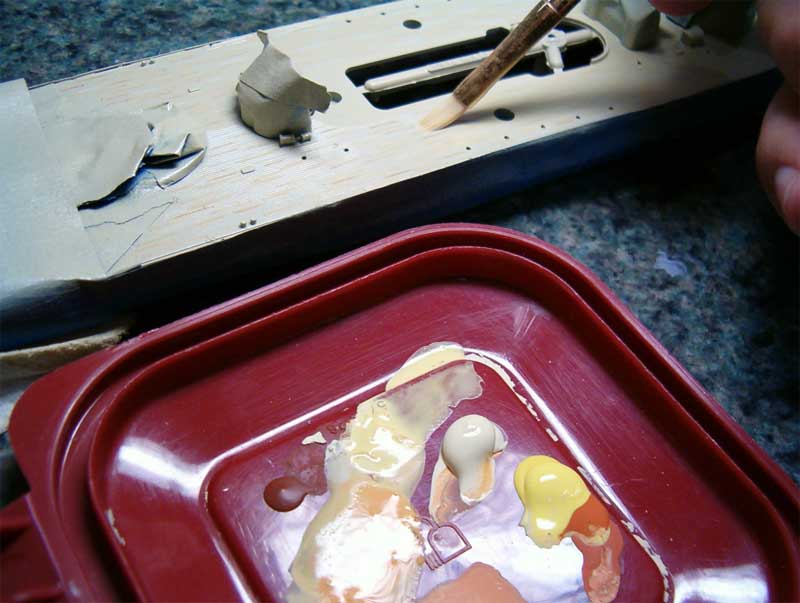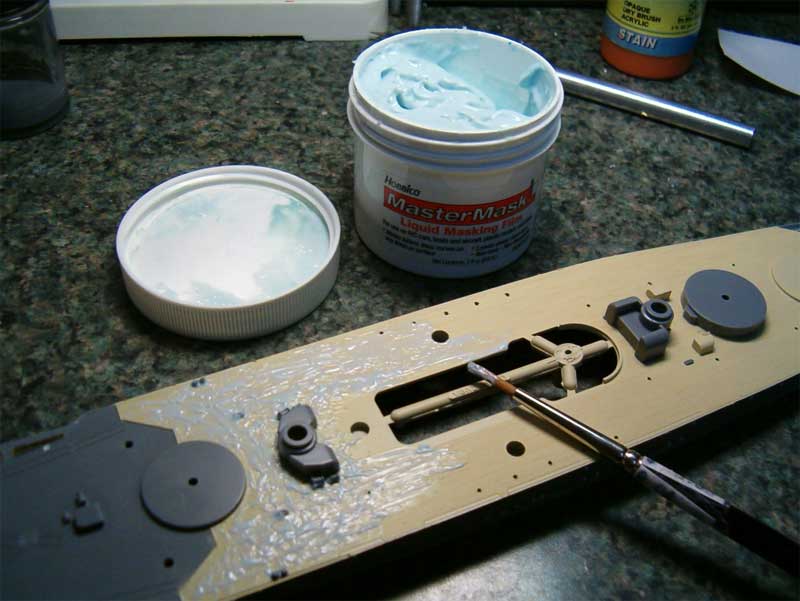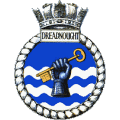You are viewing the archived version of the site.
Go to modelshipwrights.com for the current dynamic site!
Go to modelshipwrights.com for the current dynamic site!
1⁄700Build Up of the Tamiya 1:700 IJN Yamato
8
Comments
Painting the Wood Deck
Once the major work on the hull is complete, I like to paint the wood deck before finishing the hull details. Painting the deck at this stage ensures you will get all areas of it with little masking and worry about fragile photoetch railing and details. We will then mask the deck with a liquid mask film to protect it while we add details and paint the hull. I decided to paint part B15 before gluing it.The Yamato’s deck was a wood called teak. It looks a lot like pine but has more of a yellow-gold look to it. I masked off some areas with blue painters tape and washed the deck with water and a paper towel to remove oil and fingerprints. I don’t like to use primer on smaller models as it sometimes ruins photoetch detail if applied to thick. I first applied a generic ColorPlace brand of Almond color from a spray can. After checking that the coat was even and all nooks were covered, I let the coat dry several hours.

I next took watercolor pencils of various shades of browns and white and drew lines at random across the deck. In the open areas I chose a length of about 1/2 inch for a uniform look. I made sure all areas between objects had some planking drawn on them as well. When satisfied I mixed the water-based acrylic paints as shown in the photo until I got a pleasing gold color. This was then thinned and brushed across the deck with a stiff flat brush. The watercolor pencil lines and thinned acrylic paint were slowly blended together until I was satisfied with the result.

Once the acrylic paint has dried (which only took a few minutes), I lightly sprayed over the deck with a couple quick swipes of the almond color spray again to finish the blending. Once dry, the deck was coated with ModelMaster lusterless flat spray to seal and protect the acrylic paint. This was allowed to dry for several hours.

After the flat spray had dried for several hours, the tape was removed and the edges cleaned up. The hull will be spray painted with a can of Tamiya’s IJN Kure Grey, The brush bottle of this color does not go on unprimed parts well, so I mixed an empty bottle of the color with various ModelMaster enamels and color matched it on a piece of photo paper for printers. I painted the reels, deck hatches and other small details with this color now. I then carefully brushed on the liquid mask being careful to leave the gun mount edges exposed so they would be painted.
After several hours the film was dry and I cleaned the straight edges around objects with a sharp hobby knife blade. Part B15 had tape put on its deck in front of the breakwater barrier and between it and the reels, Testors clear Dullcote in a bottle was brushed on the seam to seal the taped edge. The front of the breakwater was then painted. After dry the tape was removed, B15 was attached to the hull piece and the wood deck was masked off. The gap between the breakwater barrier on B15 and the hull was filled in from the other side with clear parts cement.
Comments
Thank you Anthony for sharing this incredible build with us. This is one of the finest ship models I've ever seen and in 700th scale no less! Your step by step instructions are much appreciated. There are enough construction tips there to keep me coming back over and over.
Thanks again Anthony for a majestic build and thanks Mark for posting.
Frank
JUL 20, 2008 - 02:36 AM
Hi Anthony
Thanks for writing this future reference great article!
I know that it is supposed to be used with the AOTS book (just "sitting" there looking at me), but I must say that you already have cut the path through the jungle - if I might use this way of expression!
Also I would like to make a small correction on a little thing and a challenge...
correction: you called the wooden thing on the stern a raft. It isn't, it is a emergency rudder;
challenge: you have gone the extra mile on this beauty, and although I could accept the water base for other model, in this particular case, I would say that it deserves a better one
Congratulations Anthony!!!
Rui
JUL 20, 2008 - 09:12 AM
Simply one of the best I've seen in a long time.
Thank you for sharing!
JUL 20, 2008 - 02:50 PM
Amazing workmanship there Anthony. Thanks for sharing and giving up all those tips and tricks. I know where I am going to be looking when I start working on my Musashi and Yamato models. One heck of a build and shows just what can be accomplished with the divine scale and some careful work.
JUL 20, 2008 - 04:51 PM
instant bookmark... just gorgeous,, hope my 350 nagato comes out 1/10th a s good as this one... will be watching and going over this one a long time, thanks for sharing!
JUL 22, 2008 - 11:24 AM
Thank you all for your replies. I really enjoy reading full buildup articles and thought I'd write one of a model I had a reference book and several sets of photoetch for. To spite several revisions I still can see alot of spelling/grammer errors I made in the document.
This model also recently won First place, Judges grand and several other awards in a local IPMS show, I was very pleased. Your right that I took the easy way out on the water and perhappes I'll practice and try one day on giving it a better base.
A reason this looked so good is that the kit itself is awesome. It comes with peices to build all versions of the Yamato. I'm going to be using it to build a 1944 Musashi in the future. If you want a good looking kit out of the box this is it. I highly recommend it.
JUL 22, 2008 - 12:59 PM
Indeed Anthony (I have both the Yamato and Musashi in the stash, waiting for better skills)
Thanks again
Rui
JUL 23, 2008 - 12:54 AM
Copyright ©2021 by Anthony Kochevar. _OPINIONS Model Shipwrights, KitMaker Network, or Silver Star Enterrpises. Images also by copyright holder unless otherwise noted. Opinions expressed are those of the author(s) and not necessarily those of Model Shipwrights. All rights reserved. Originally published on: 2008-07-20 00:00:00. Unique Reads: 39630












